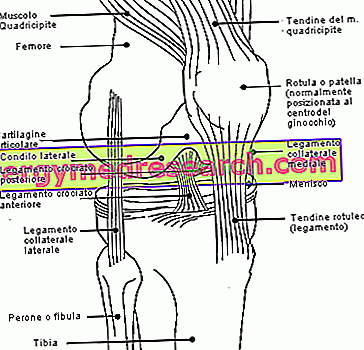Let's talk about the knee, trying to give an explanation to all those pains that afflict him and, if possible, to advise the remedies and treatments currently available
A QUICK LOOK AT THE ANATOMY OF THE KNEE

All articular surfaces are covered with cartilage, a special protective fabric that reduces friction inside the joint. A further protection from trauma and wear derives from the presence of two meniscuses, one medial and one lateral. Both of these semi-lunar shaped structures work as shock absorbing bearings, facilitating movements and protecting the entire knee.
A fibrous sleeve, called a capsule, wraps around the entire joint, stabilizing it during movement. A membrane, called synovial, covers the inner surface of the capsule and secretes a viscous liquid that lubricates and nourishes the joint.
The knee is also stabilized by four strong ligaments: two lateral ones called medial or internal collateral (LCM) and external lateral collateral (LCL) respectively, and two internal ones called anterior cruciate (LCA) and posterior cruciate ligament (LCP).
There are also numerous other anatomical structures such as bags and minor ligaments which together provide for increasing the stability and functionality of the joint.
Knee injuries and pathologies
Due to the presence of numerous anatomical structures, the pathological processes affecting the knee are numerous. However, statistics in hand, we find that classifying these injuries is not that difficult. We can make a first great distinction by separating degenerative pathologies from those of a traumatic nature:
DEGENERATIVE PATHOLOGIES: due to small muscular and articular imbalances, with the passage of time and with repeated use, the knee slowly encounters more or less serious alterations. This is the case, for example, of arthrosis, a disease that affects and articulates articular cartilage. Other examples of diseases that accelerate the degenerative phenomena of cartilage or bones are: gout, scleroderma and diabetes.
A separate category should be made for infectious (rheumatoid arthritis) and tumor processes. Fortunately, the hypothesis that knee pain is linked to these diseases is rather remote.
Osteoarthritis of the knee
X Problems with video playback? Reload from YouTube Go to Video Page Go to Wellness Destination Watch the video on youtubeTRAUMATIC DISEASES: in sports, the knee is the joint most frequently affected by injuries. Following a trauma, one or more structures that compose it could indeed be damaged. Often these lesions alter the normal articular relationship of the knee and, if they are not adequately treated, they risk, in the long run, to give rise to degenerative processes.
In humans, the traumatic and degenerative aspect generally prevails, due to heavier sports and work activities. Instead, women are more prone to problems due to weakness or muscle imbalance; after menopause the risk of osteoarthritis increases significantly.
RISK FACTORS
Obesity
Old age
Sport, especially of contact with high traumatic risk
Old knee injuries
Dietary factors (vitamin D deficiency)
Weaknesses and muscle imbalances
REMEMBER TO:
contact a specialist to prevent small damage from becoming a major problem
Interpret the pain in relation to its characteristics
WHERE IS IT?
pain in the front of the knee: it is probably linked to problems with the extensor apparatus (femororotuleal pain syndrome, patellar tendonitis)
pain in the medial part (internal): linked to problems of the medial meniscus or medial collateral ligament
pain in the external part (lateral): more rare, it may be due to a lesion of the lateral collateral ligament (after a traumatic event), of the lateral meniscus or to the syndrome of the iliotibial band (in sportsmen, especially runners who run downhill)
pain in the back: (rare), could be caused by lesions of the posterior cruciate ligament
Knee: second part »



